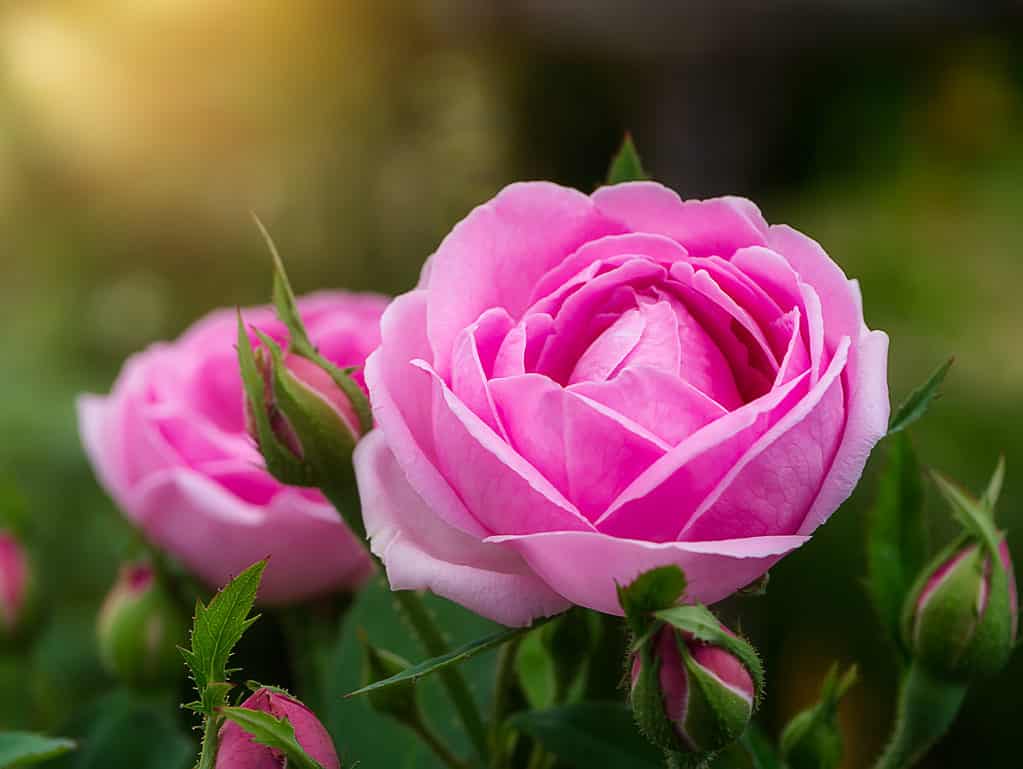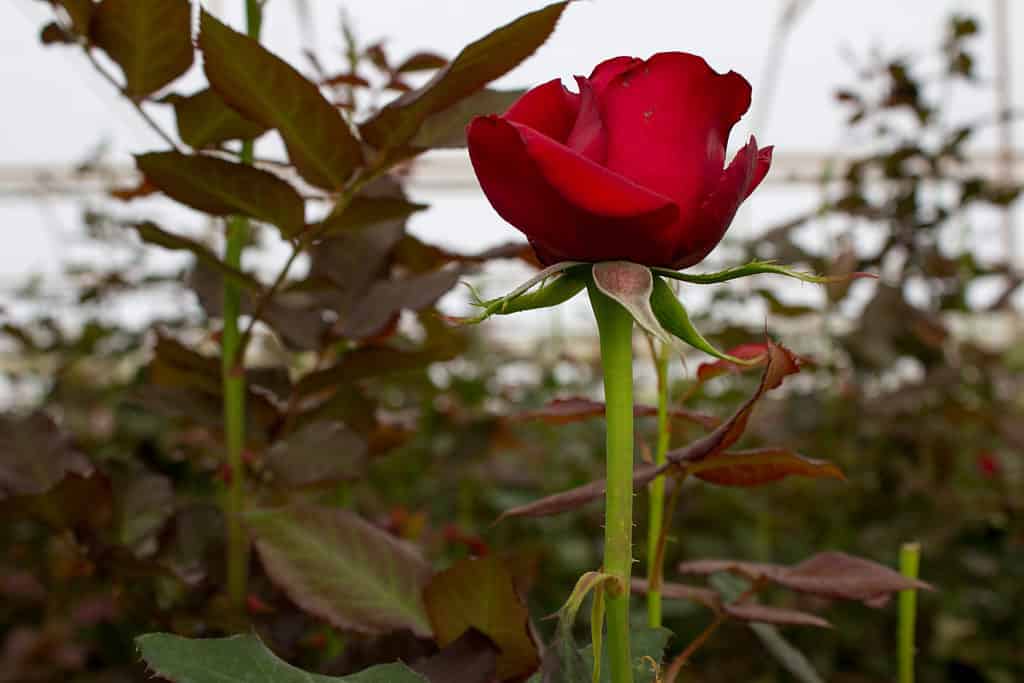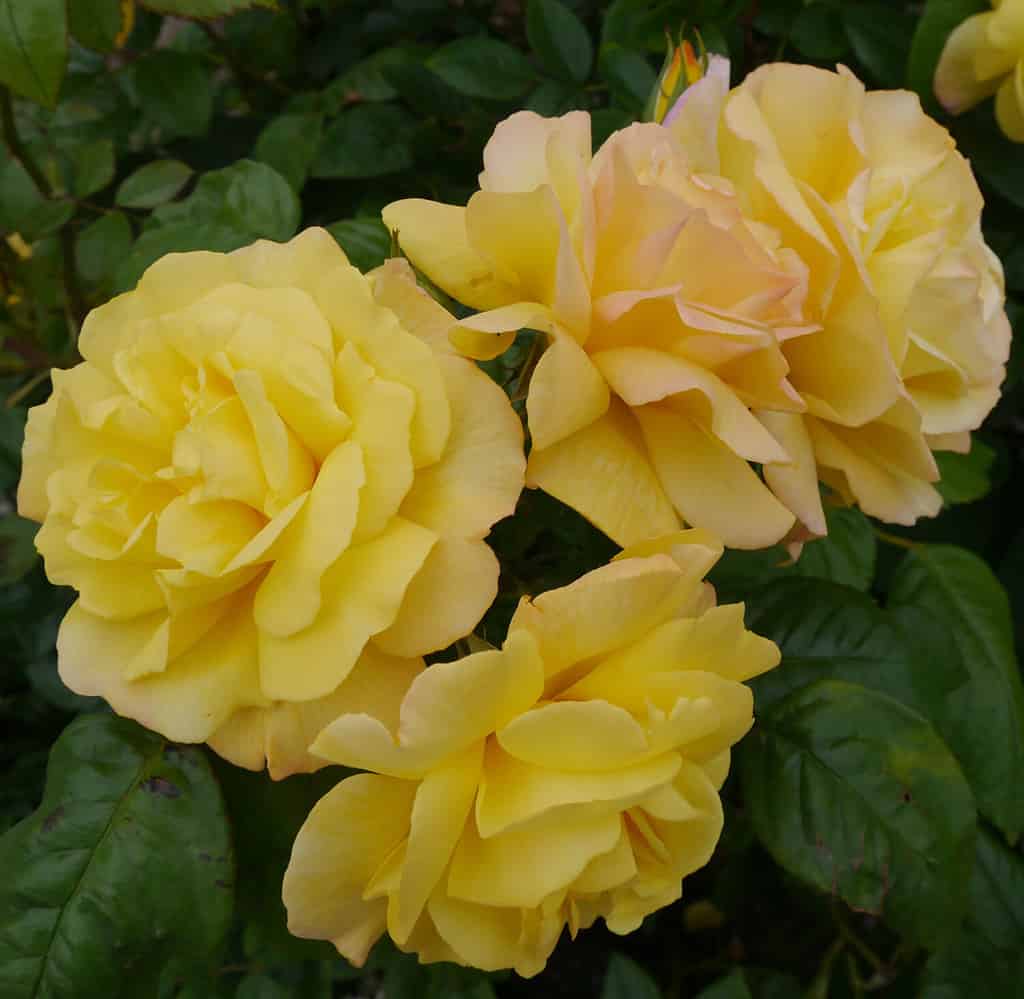Roses are iconic and a perennial favorite among flower lovers. They make stunning centerpieces, boutonnières, and bouquets. Strewn rose petals signify romance. And properly tended rose bushes make a beautiful addition to any landscaped area. Given their popularity, it would be easy to assume that all roses are created equal. However, that is not the case. There are over 100 species and thousands of cultivars in the Rosaceae family. In the article below, we will take a look at two broad categories: garden roses and roses. You will discover ten characteristics that distinguish each from the other and how to care for both.
Let’s dive in.
Garden Roses
Garden roses are a specific category of ornamental roses grown for the beauty and fragrance they add to a garden. Most garden rose hybrids bred specifically for large, showy blooms and sweet scents. They come in a variety of shapes, sizes, and colors. So, you can find red, pink, purple, and yellow roses to match your style. They are often more fragrant than other types of roses and are a popular choice for cut flowers.
This category of roses doesn’t have a specific classification but do have a few distinguishing characteristics, including:
- Size: Typically, garden roses are larger and more showy than other roses.
- Fragrance: Breeders often select the most fragrant flowers when growing garden roses. This effort has led to incredibly delightful aromas among the ornamental garden roses.
- Disease Resistance: Most garden roses are more disease-resistant and can resist common diseases such as black spots, rust, and powdery mildew.
- Cost: Garden roses are usually more expensive due to the extensive cultivation efforts and high retail demand.
- Use: Most often, garden roses get used for decorative purposes.

Garden roses are beautiful ornamental plants.
©NOPPHARAT9889/Shutterstock.com
Roses
When used generally, the term “rose” includes all members of the Rosa genus. And more than 100 species and thousands of cultivars are represented in this group. They live in nearly every environment, from temperate forests to arid deserts. These plants also come in a range of sizes, shapes, and colors. Here are a few of the general characteristics of roses.
- Diversity: These lovely plants are incredibly diverse. There are seemingly endless shapes, colors, and sizes available.
- Uses: Roses are suitable for many purposes, including medicinal and food applications. Rose oil and rose water get commonly added to skincare products. And the amazing rose hips are a popular supplement due to their high vitamin C content.
- Growing Conditions: Many rose species are often quite hardy and tolerant of varying growing conditions, depending on the species. They can thrive in different soil types.
- Growth Habit: Rose plants are perfect climbers that will add intrigue to any trellis or arch. They also commonly get grown as shrubs and hedges. Most rose plants can get trained to develop into any shape or size you desire.
- Fragrance: The fragrance of roses varies widely. Some cultivars are highly fragrant, while others have little to no scent.

Roses are generally smaller than garden roses.
©nataliaec/Shutterstock.com
10. Differences Between Garden Roses and Roses
Garden roses technically fall within the broader category of roses. However, there are some key differences between the two. Here are ten of the primary differences between both categories.
1. Shape
Hybrid garden roses are typically softer, with smoother lines than standard roses. The latter usually has a tighter shape that features pointed petals.
2. Size
Generally speaking, roses can range from large to small in size. But ornamental plants are usually bred to feature larger blooms.
3. Fragrance
Garden roses don’t have a specific scent. However, they do have the classic fragrance associated with the lovely rose. In addition, they are significantly more fragrant than other species.
4. Diversity
The general rose family has an incredibly diverse range of flowers. They vary greatly in size, shape, and color. While there are countless hybrids, they are more uniform than other species.
5. Cost
If you have ever looked at the cost of roses at a nursery versus the cost of cut roses at a flower shop, you may have noticed a significant price gap. That is due to the fact that garden roses often take more effort to cultivate and are in extremely high demand. So, they will usually cost more than their cousins.
6. Uses
Unlike garden roses, other species in this plant family have a wider range of applications. Garden roses are most commonly used for decorative purposes. But the broader family of roses gets used for medicinal purposes and can get incorporated into food preparations.
7. Disease Resistance
Garden roses are usually more disease-resistant than other types of roses. That is because they have been cultivated for that purpose.
8. Growing Conditions
Most rose species are more hardy and tolerant of a wider range of growing conditions than garden roses. The latter is slightly more delicate and sensitive to shifting environmental conditions. Garden roses are most often grown as bushes. However, other species are grown as shrubs or climbers.
9. Pruning Needs
Garden roses require more frequent and specific pruning than other species. They take more care and effort to maintain their lovely bush shape.
10. Flowering Season
If you select the right garden rose cultivar, you may get treated with a longer flowering season than other roses.
Growing and Caring for Roses
Roses, in general, can thrive in many different environmental conditions. So, whether you have imperfect soil or wild temperature swings, you may find options that will thrive in your area. However, there are some general guidelines to help you ensure your lovely plants remain healthy.
- Sunlight: As with many plants, roses require ample direct sunlight. Select an area with at least six hours of sun a day. If you live in a hotter climate, try to locate a spot that also gets some shade in the afternoon.
- Watering: Roses require plenty of water. Keep an eye on the soil during hotter months to ensure it doesn’t get too dry.
- Fertilizer: Properly feeding your plants will keep them happy for years to come.
- Pest and Disease Control: Most roses are susceptible to pests and diseases. Monitor your plants closely so you can promptly address any issues.
Growing and Caring for Garden Roses
While many of the tips above work for garden roses, it is important to note that they also require specific growing conditions and care to thrive. Here are some additional tips for growing and caring for this rose category:
- Nutrients: Garden roses need a specific set of nutrients to thrive. Make sure they receive ample potassium, phosphorus, and nitrogen. The ideal balance will come through proper fertilization.
- Fertilizer: These lovely plants also require regular fertilization to promote healthy growth and flowering. Use a balanced fertilizer formulated for roses. New plants require a slow-release fertilizer applied every month. Once your plants get established, apply fertilizer every few weeks to encourage blossoms.
- Watering: Garden roses require regular watering, especially during the hot and dry summer. Water your roses deeply once or twice a week.
- Pruning: Prune your plants in early spring to promote healthy growth and flowering. Regularly remove dead or diseased wood.
- Pest and Disease Control: Monitor your plants for pests and diseases and take appropriate measures to control them. Thankfully, garden roses are largely pest and disease resistant. So you likely won’t have too many issues.
Understanding the differences between these two plants will hopefully help you choose the right one for your home or garden. The best part is that you can’t go wrong either way. Both categories offer beautiful blooms that will add intrigue to your space. Take some time to speak with your local nursery for additional help selecting the best roses for you!

Garden roses have soft, stunning blossoms.
©John R Martin/Shutterstock.com
The photo featured at the top of this post is © Salad Days/Shutterstock.com
Thank you for reading! Have some feedback for us? Contact the AZ Animals editorial team.







